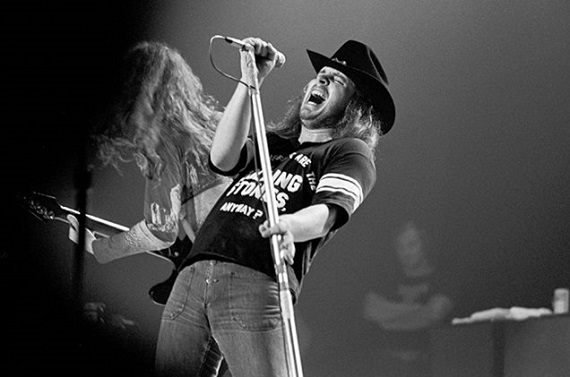We all have an idea that when we hear Southern Music, we know it, but what is it? What is it about Southern music that makes it stand out from other types of American music or music from around the world? How do you know it when you hear it? How do you explain to somebody the difference between the Blues and a Boston sea shanty?
The South has conquered the world in music. Musicians in Europe, Asia, the Caribbean, etc., copy and incorporate what they think of as an American sound, but more than likely it’s a Southern sound. But what is it?
Suppose a British musician wrote a song, and she wanted to record it in a specific way so that it sounded Southern. What kinds of things would be necessary for her to make a non-Southern song sound Southern? Would it sound like Rock, or the Blues, or Country, or Soul?
Is there a definable “Southern Cadence” in music?
Of course, there is. There a distinct musical presence in Southern music that I call the “Southern Cadence,” and it can be broken down into accessible components. It can be explained. It can be copied and followed.
The Southern Cadence is NOT a list of sound effects, and it is not a formula. There’s no step-by-step checklist to the Southern Cadence like needing 12 points to match a fingerprint. Every Southern song does not contain all elements of the Southern Cadence, and every song with elements of the Southern Cadence is not automatically a Southern song. The Southern Cadence is Music and not Science, so therefore, it’s qualitative and not quantitative. Sometimes, the Southern Cadence is inconsistent and contradictory (just like a Southerner), but you know it when you hear it.
The Southern Cadence is an integral part of the South’s unique cultural landscape, which makes it a two-way street. Southern Music gets its sound from Southern Culture, and Southern Culture gets its personality from Southern Music. They feed each other and feed off of each other. There are obvious musical fundamentals in the Southern Cadence, such as beat, tempo, scales, harmony, and timbre. However, the pace of Southern life, the Southern accent, and Southern priorities also greatly influence the Southern Cadence as well. Consequently, Southern Music returns the favor back into Southern Culture.
Southern music from as far back as we can trace it contains aspects of The Southern Cadence as it connects to the Old South. The great surge of Southern music in the 20th Century connects to the New South. Brand new, up and coming Southern musicians continue to reinforce aspects of The Southern Cadence in their new music, and they connect it all to the Future South. The Southern Cadence reminds us where we’ve been, helps us understand where we are, and guides us toward where we’re going.
There are seven key elements of the Southern Cadence that I have identified as follows:
RELAXED: Southern songs often have a slightly slower tempo compared to other genres, creating a laid-back, mellow feel. To put this into perspective, consider two different types of “relaxing.” First, there’s simply sitting quietly and relaxing. And then, there’s sitting in a rocking chair on a front porch on a warm evening with a glass of sweet tea watching lightning bugs and listening to distant thunder. Southern music is THAT kind of relaxed. Even Southern music that has a fast tempo is still relaxed, and not frenetic.
GROOVE: The rhythms of Southern Music are typically very pronounced, with a strong backbeat and syncopation, often using shuffle rhythms. Even in songs with a faster tempo, the shuffle feel still gives a laid-back feeling to the beat. Also “groove” refers to the technique of NOT following strict divisions of the beat, which allows the rhythm to be imperfect (speeding up and slowing down). As simply put as possible, Southern music is NOT about what happens on the beats, but what happens in all that glorious space in between the beats. The Groove lives somewhere in between the Beats, and that’s where the identity of the Southern Cadence can be found. It’s less about precision and more about a natural conversational quality. The Southern way of life lives inside the Groove, and the music becomes more of taking your time, savoring the moment, and connecting with people. The music becomes Southern culture through the Groove.
SIMPLE MELODY: The melodies of Southern Music are often simple and catchy, with a focus on repetition and hooks instead of sophistication. Southern songs tend to stick in your head easier than other songs. Also, Southern melodies freely use “blue notes,” which are pitches that are somewhere in between exact scale notes, and help contribute to the lazy aspect of the song. Just as the Groove in Southern Music lives somewhere in between the beats, the melodic pitches in Southern Music live somewhere in between the notes of the scale. The inflections represented by the blue notes tend to follow the speech patterns of the spoken Southern accent.
SOUTHERN ACCENT: The melodies in Southern Music (both instrumental and vocal) are often warm and expressive, with a Southern drawl or twang either obvious or implied. If you were to randomly select any Rock ‘n Roll song from the 1950’s, you’d be listening to a Southern accent. The various elements of the many varieties of Southern accents are dominant in the presentation of the melody, whether it’s vocal or instrumental.
Southerners have a built-in sense of melody because of the way we speak.
The Southern accent is the most obvious driving force behind the elements of the Southern Cadence in music, which has many unique characteristics. This also applies to all areas and sub-cultures within the South, such as hillbillies, blacks, Cajuns, Texans, etc. They are as follows:
- Drawl: The Southern drawl is arguably the most distinctive feature of the Southern accent, and involves the lengthening of vowels within words. The relaxed, melodic cadence found in the Southern drawl gives the illusion of speaking slower, and it connects across the aisle to the Southern Cadence aspects of the Relaxed Groove.
- Vowel Alteration: Officially, this is known as SVS, or Southern Vowel Shift. The alteration of vowels gives the Southern accent a quality of pronouncing words differently from standard pronunciation. “Pen” becomes “PEE-yun,” and “window” becomes “winduh.” When a Southerner pronounces “pen” as “PEE-yun,” three different things happen. First, the vowel is pronounced differently. Secondly, one syllable is stretched into two syllables, which gives the word a rhythm. Third, the two syllables are descending in pitch, which gives the word a melody. Somehow, Southerners can make a full melody with pitch and rhythm out of a simple three-letter word.
- Syllable Stress: Words like “cement”, “umbrella”, and “police” are spoken as “CEE-ment”, “UHM-brella”, and “PO-leese.” In linguistics, this is called “prosodic dissonance,” and helps lead directly to unique rhythms and inflections in Southern music that are never found elsewhere.
- Unique Vocabulary: Words like “ain’t”, “buggy” (shopping cart), “coke” (any soft drink),”tote” (carry), “mash” (push), or “tump” (drop off). This also includes grammatical variations, such as using “y’all” as a plural second-person pronoun, “fixin’ to” meaning “about to”, or “might could” for “might be able to.”
- Dropped “R”: The “r” at the end of words is often dropped, which is called “non-rhotic.” “For sure” becomes “fo’ sho,” “Keep your hands to yourelf,” becomes “Keep yo’ hands to yo’self,” and “One more time,” becomes “One mo’ time.”
Since a melody is a succession of pitches that go together, then a melody is not a random sequence of pitches. Southern music has better, more catchy tunes than non-Southern music because Southerners think melodically. Southerners add pitch and melody to words through the Southern Accent, and speak that way. Since Southerners speak that way, they get used to hearing speech that way, and ultimately think that way. In other words, Southerners think tonally and melodically.
Many languages around the world are “tonal languages,’ in that they require a correct pitch to go along with correct pronunciation, such as Vietnamese or Mandarin Chinese. Chinese has about five of these tonal nuances, and a word’s meaning depends on the pitch. Although English is not a tonal language, I firmly believe that the Southern Accent is a tonal dialect of English.
Since Southerners talk in melodies, listen to melodies, and think in melodies all day every day, we create music by simply taking dictation from the music we’ve already got inside our heads.
You would think that the Boston accent should produce a unique musical sound of its own, but it doesn’t. Neither does the Brooklyn accent, not the Midwestern accent, nor the California accent. Only the Southern accent does that. The reason is that Southern music influences the accent, and the accent influences the music right back again. It is a perpetual-motion, self-feeding machine. The accent creates the music and the music creates the accent. Nobody else has that.
Each sub-dialect of the Southern Accent has its own distinctive melody and rhythm, often influenced by regional music and culture. The Appalachian accent is different from the coastal lowland accent, which is different from the delta accent, the Cajun accent, and the Texas accent. So is the music. The regional Southern accents influence the music, and the regional music influences the various Southern accents. The two are closely connected.
You have to sing the way you talk.
As our Abbeville colleague Joe Stromberg excellently explained in his book, Southern Story and Song, if you sing a Country song without the Southern Accent, then it ain’t a Country song.
MODAL HARMONY: Typically, Southern music favors the mixolydian mode instead of the major key, and the dorian mode instead of the minor key. Each of these modes adds a unique twist of flavor to traditional melodies. The mixolydian mode is slightly darker than the major scale, which is achieved by lowering the 7th degree of the scale by a half-step. Therefore, most songs in a standard major key are happy, bright, and positive, while songs in the mixolydian mode are happy, but with a touch of melancholy. Consequently, the dorian mode is slightly brighter than the minor scale, which is achieved by raising the 6th degree of the scale by a half-step. Therefore, most songs in a standard minor key are sad and lonely, while songs in the dorian mode are sad, but with a touch of hope. Sweet Home Alabama and Free Bird are two songs in the mixolydian mode, and In Memory of Elizabeth Reed is a song in the dorian mode. There is no evidence that neither Lynyrd Skynyrd nor The Allman Brothers Band specifically aimed to compose songs in modes instead of standard scales, but they were writing melodies that were living freely inside their heads.
INSTRUMENTATION: The instrumentation typically includes guitars, bass, drums, and keyboards, with occasional use of banjo, pedal steel guitar, fiddle, and harmonica. Southern Music does not use any exclusive instruments that aren’t used by everybody else, but Southerners tend to make those instruments sound different. For example, the slide guitar can be found in Hawaiian music, African music, and Indian music, but nothing sounds quite like the unique, iconic presence of the Southern slide guitar.
HOME: Many Southern songs are about the land instead of dreams and ideals, and this is something that was initially suggested by another of our Abbeville colleagues, Alan Harrelson. At the 2018 Abbeville Summer School Conference, he brilliantly described how a significant number of Southern songs are about the land, including crops, fields, hills, and valleys. Yankees don’t sing about the land very much, but we do. I’ve expanded his idea so that I call it the concept of HOME, which includes the land (fields, crops, valleys, mountains, rivers, skies, trees) as well as church, people, food, and everything else that folds into the concept of Southern culture. And we just can’t stop singing about it.
In fact, all you need to do in order to understand the difference between the South and everybody else is to consider the lyrics of The Battle Hymn of the Republic and the lyrics of Dixie. The Union/Northern anthem known as The Battle Hymn of the Republic is a song about marching, trampling, swords, lightning, fires, wraths, and altars. Good grief, that song is exhausting. By comparison, what is Dixie about? It’s about HOME. Dixie is about just wanting to go HOME. The single most important song in the 400 history of the South is simply about wanting to go HOME. It’s not about slavery, or rebellion, or secession, or treason, even though Yankees will tell you it’s about slavery. No, Dixie is about HOME, and Yankees can’t stand that. They don’t want us to feel good about the South. They weren’t able to shoot it out of us, they can’t legislate that out of us, and they can’t humiliate it out of us. We love the South, and in case they should ever forget that, we just can’t stop singing about it.
If you started playing all the Southern songs that sing about HOME (the land, the people, the faith, the food), you’d notice that there’s not enough time to play them all. However, nobody will sit in a bar somewhere tonight and sing a song about how much they miss New Jersey.
And in case you missed the obvious analogy, going to the South represents going Home, and going Home represents going to Heaven. To Southerners, Dixie IS Heaven, and Hank Williams, Jr. came flat right out and said it when he sang, “If Heaven ain’t a lot like Dixie, I don’t want to go.” The first time we all heard that song, we didn’t cringe at the implied blasphemy. Instead, we all probably thought, “The boy’s got a point.”
We spend too much time talking about Southern history and not nearly enough time talking about Southern culture. There is one specific aspect of Southern history where we have a losing record, but there are no areas of Southern culture where we have a losing record. In fact, we are undefeated when it comes to Southern culture. We kick everybody’s butt when it comes to literature, food, and especially music. The Southern Cadence is the heartbeat of our entire culture. The only way to destroy a culture is to eliminate everyone who believes in it, and I’m not dead yet.







“The Southern Cadence is the heartbeat of our entire culture.”
That’s because it comes from the heart.
I wonder for what tune Ronnie is reaching back for more in the picture?
The t-shirt is from ’76 – ’77. I think he’s near the end of “That Smell”, letting loose with “One more blow for my no-o-o-ose!!!” before stepping aside for Allen Collins’ and Steve Gaines’ call-and-response guitars. Never possessed of the voice to shout his way through a tune, most images of Ronnie show him stalking the stage, exerting only to herd the players to the front. The most intense of Skynyrd songs, Ronnie’s “morbid” story about Gary Rossington’s and Billy Powell’s drug fueled brushes with death may have driven him to a dramatic ending.
they blather about Massachusetts in this one ….it sounds ok though. https://www.youtube.com/watch?v=Gy88-5pc7c8
Thank you, Mr. Daniel, for your entertaining and thoughtful article. Yes, the ubiquitous reference to “losers” (referring to the War, or course) by Yanks and others uninformed can’t overcome that Southern culture is the envy of the land, if not the world. At any rate, now at least I can spend the rest of my day with “Dixie”, Bocephus, and, from Gordon’s response, “That Smell” playing in my head.
Excellent. Loved the mixolydian and Dorian explanations….
https://www.instagram.com/reel/DDe9LIktb-p/?igsh=a2xqenRxb2ZweDZh
While I was learning about my Southern Planting heritage, I was doodling on my family parlor guitar, an Ashborn from 1848. Music just came out and they sounded like complete songs, instrumental only and very much like Dr Daniel portrays. Very much.
Thank you sir
Album is called “My Old American Home” buried somewhere in iTunes